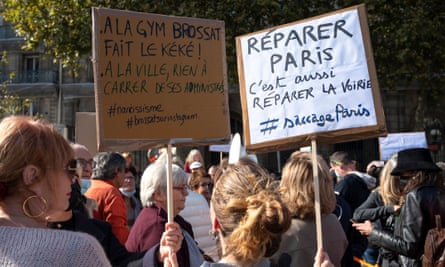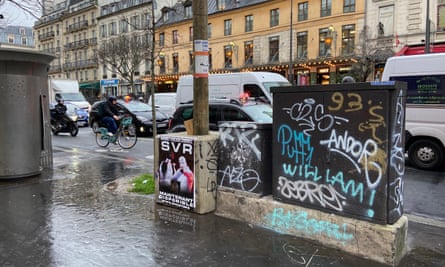In the middle of Paris’s third Covid lockdown last March, a hashtag appeared on Twitter with a photo of a lock on the Canal Saint-Martin that runs through the north of the city clogged with litter, plastic bags and bottles.
Images of Paris looking worse for wear are nothing new but, within days, dozens of pictures of overflowing bins, broken pavements and graffiti-covered walls appeared with the same hashtag – #SaccageParis – which roughly translates as Trashed Paris.
Today, less than a year on, the hashtag has been used more than 2.7m times on Twitter alone and has become the battle cry for those who fear the once beautiful city is losing its soul. To others, it is a political smear campaign aimed at the Socialist mayor Anne Hidalgo, also a candidate in this year’s presidential election.
Unlike traditional protests, Saccage Paris photographs the streets instead of occupying them. The informal campaign has given disgruntled Parisians a catchy hashtag under which to complain about anything from potholed pavements and roads to ugly park benches, litter, fly-tipping and graffiti.
Whatever the motivations behind the hashtag – the account PanamePropre that coined it remains resolutely anonymous – the movement is gathering momentum and has prompted City Hall to publish a “manifesto for beauty” to smarten up the city, which hosts the Olympic Games in 2024.
Jacques Desse does not look or sound like an extreme urban warrior. The softly spoken bookseller would almost certainly prefer to bury his nose in a rare manuscript than speak to the press. But he is angry, and he is not alone.
A member of Saccage Paris, he laments the destruction of the city’s historic symbols. Much of the movement’s fury has been targeted at City Hall removing, neglecting or replacing Paris’s instantly recognisable architectural heritage, notably the street furniture, much of it dating from the 19th-century second empire of Napoléon III.
“For many of us, Saccage Paris has no political motive. It’s a citizens’ movement and there’s a wide mix of political opinions. What we reproach Anne Hidalgo and her team for is that they have the power to do something about this but they do not use it positively,” Desse told the Observer. “City Hall is annoyed with us because what we show damages its image… but we have no other way.”
To outsiders – especially fans of Netflix drama Emily in Paris – the French capital is the picture-postcard city of romance and dreams, of baguettes and boulevards, of high culture and haute couture. Parisians, who live in one of the most densely populated cities in the world, often paint a different picture. Last month, France’s best known royal commentator, Stéphane Bern, announced he was moving out of Paris because it had become dirty, violent and was “a rubbish bin”.

“What has happened to the City of Light?,” he said. However, Bern pointed the finger at ordinary Parisians not Hidalgo. “Her job is far from easy, and, as far as I’m aware, she’s not the one making it dirty, nor are the refuse collectors at fault. The biggest culprits are first and foremost the people. She certainly has her share of responsibility but she doesn’t deserve all the attacks aimed at her,” Bern added.
Art historian Didier Rykner was less forgiving in his recent book La Disparition de Paris (The Disappearance of Paris), a detailed critique of Hidalgo’s management of the city. But even writing books about the state of Paris is hardly novel. In 1832, Victor Hugo published a pamphlet decrying the “vandals” razing the crumbling medieval towers and churches to build replacements in the then fashionable neoclassic style, and Baron Georges-Eugène Haussmann, credited for the vast 19th-century transformation of Paris and creator of the celebrated grands boulevards, faced bitter opposition and controversy.
PanamePropre has said he is only expressing “the anger of seeing the city I have lived in for more than 20 years deteriorate before my eyes. Thousands of Parisians, and Paris lovers from all over France, ordinary citizens like me, spontaneously united under this hashtag,” he wrote.
“It’s amazing how it has caught on,” said Quentin, a young engineer and Saccage Paris activist, who preferred not to give his full name. We are in a cafe near the Porte Saint-Martin in Paris’s 10th arrondissement, where a local hairdresser has painted a large pair of scissors on the pavement under the 17th-century arch. “That is the sort of thing Saccage Paris is about. I’ve reported it but it’s still there,” he said.
“It’s true the hashtag has been used by some on the far right, but it’s a hashtag, anyone can use it. That’s just an excuse, the real issue is the damage and removal of the very things that make up Paris’s heritage: its fountains, lampposts, the grilles around the trees, the Metro entrances, the benches … if you see a picture of these things you know exactly where you are. You don’t need a picture of the Eiffel Tower to know it’s Paris, it is instantly recognisable. But the city authorities have been wilfully destroying them for years. When they replace an old bench seat with a new concrete one, it is the identity of Paris they are destroying. It’s deliberate vandalism of the city.”
He denied supporters of Saccage Paris are architectural reactionaries. “They say we are against anything modern, that we are opposed to change, but again that’s an excuse. There are some very good modern things, but is a modern concrete bench that is ugly a good thing?”
Desse’s cavernous bookshop, behind an anonymous-looking door in the Goutte d’Or, in what is called a “quartier populaire” – a poor, working-class area, with a large migrant population – is down from the Porte de la Chapelle, the northern “gate” where visitors arriving by road meet the chaos of the city head on. The bookseller, who lives above the shop, says the local community feel the municipal authorities have abandoned them.

“We have seen the destruction of the urban landscape and disorganisation here and across the city over the last 10-15 years,” Desse said. “The authorities try to do something – more social housing, more cultural centres, more of this and that – but the result is more often than not catastrophic, and they don’t listen to us. It’s like a company run by a bad boss – things are bad all the way down and nothing works.
“They are not in touch with reality: perhaps they consider this is normal, that in the north-east of Paris it’s normal to have poor districts where everything is dirty, where there are social problems and drug problems and nothing is done about them. Perhaps they will only notice these problems when they spread elsewhere. Before it was just a few districts like ours that suffered, but now…”
City Hall maintains that the movement can be traced back to supporters of the far right and is orchestrated by Hidalgo haters. Like the rubbish on the streets, it is easy to see why, when a social media post about the state of Paris often sparks virulent, sometimes defamatory, attacks on the mayor.
Still, officials have reacted to the barrage of criticism. One of Hidalgo’s deputies, Emmanuel Grégoire, recently announced City Hall would publish a three-volume “manifesto for beauty” with plans to smarten up the city and admitted Saccage Paris had made some “useful” points, though he accused it of exaggerating. Grégoire said measures included replacing ugly urban furniture, zero tolerance for rubbish dumping and increased efforts to combat graffiti tagging and illegal fly-posting.
Carlos Moreno, a French Colombian scientist, university professor who has lived in Paris for 42 years and acted as an independent adviser to Hidalgo, said the problem was one of centralised authority and lack of joined-up thinking, particularly on rubbish collection and disposal. He urged officials to delegate more to local mayors and appoint an international “chief city designer” with a team of urban experts to oversee aesthetic changes at street level.
“The beauty manifesto isn’t enough. These things shouldn’t be decided by civil servants, we need experts,” Moreno said. “Of course, we should keep things that are part of Paris’s heritage, but that doesn’t mean everything old should be kept. And, of course, Paris shouldn’t be a museum so we should have things that are modern and cool but not if they are ugly.”
Moreno pointed out Paris has unique challenges caused by its density and the fact it was one of the most visited cities in the world.
“It’s not right to say Paris is a rubbish bin; there have been some failures but there have also been some great successes under Anne Hidalgo. Say what you want about her, she has a great vision for the city and I am optimistic for the future,” he said.
One thing both sides agree on is that the future for the City of Light is, or could be, bright.
“When we started this, City Hall claimed we were all reactionaries. We’re not, but they need to start listening to us,” “I’m optimistic, but I must fight for this city and its heritage,” Quentin said. “We have to find a way to make Paris beautiful again.”
